Transit: streetcars vs. enhanced bus service plus Columbia Pike streetcar planning in Virginia
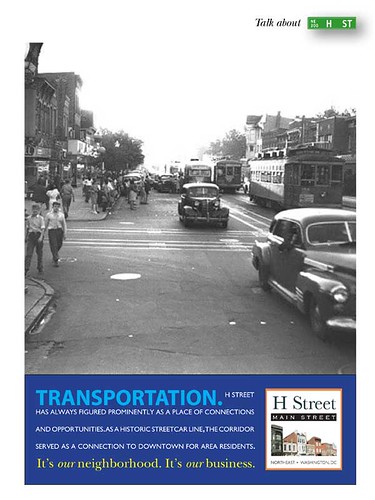 Intersection of 8th and H Streets, NE from the 1940s. Image from the Leroy O. King Collection, compliments of Lee H. Rogers. Image advertisement created by Kevin Palmer from a concept developed by Richard Layman.
Intersection of 8th and H Streets, NE from the 1940s. Image from the Leroy O. King Collection, compliments of Lee H. Rogers. Image advertisement created by Kevin Palmer from a concept developed by Richard Layman.Today's Washington Post has an article about the proposed Columbia Pike Streetcar line that would serve Arlington and Fairfax counties, "Fairfax Board on Track To Consider Streetcars." From the article:
Arlington and Fairfax officials said they hope that the convenience of the $120 million system -- combined with the nostalgia for rattling trolleys of days gone by -- will entice riders out of their cars...
A big "if" is how Arlington and Fairfax would pay for the line. Officials said much of the cost may have to be borne by local jurisdictions because federal transportation funds are scarce. They concede that the project is unlikely to be funded by the key Federal Transit Administration program for light rail and subways. That's because traffic models show that the streetcar would not reduce road congestion dramatically and would slice just nine minutes off a typical ride. Another drawback is that the streetcars would not have a dedicated lane; the flat tracks permit vehicles to drive over them.
Streetcar critics have said it would snarl traffic and that better bus service would have the same benefits and cost less. Proponents said a streetcar would be valuable because it would eventually attract the elusive "choice" riders -- car owners who use Metro for convenience or gasoline savings.
_______
I think that transit advocates and opponents need to understand the differences between the DC region and Portland, and the area where the Portland Streetcar has been installed, when applying that experience here.
I am as big a proponent of streetcars as I am of historic preservation. In fact, I think the system needs to be made interoperable with historic and historic replica streetcar vehicles to promote cultural heritage objectives, just like the Portland Streetcar system.
 On weekends the Portland Streetcar system runs a replica streetcar.
On weekends the Portland Streetcar system runs a replica streetcar.The major difference is that so many more people ride transit, both bus and rail, in the Washington region compared to Portland, Oregon, even though Portland is considered to be the poster child for great transit usage.
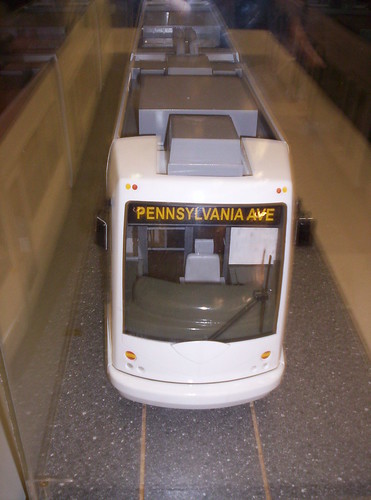 Model of a streetcar for DC produced for the DC Transit Studies.
Model of a streetcar for DC produced for the DC Transit Studies.There is another difference between the Portland system and the areas, where for the most part, streetcar service is being proposed in the Washington region--the official proposals for 8 lines in DC and one in Virginia, and my own unofficial two proposals for service in Prince George's County, Maryland (one extends the DC "Crosstown Line" from Brookland to the University of Maryland campus via Michigan Avenue, Queens Chapel Road, and Adelphi Road; the other provides service from the Rhode Island Avenue Metro to as far as Laurel, Maryland).
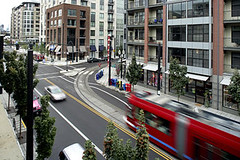 Portland Streetcar in the Pearl District. Photo from the Hoyt Street Properties website.
Portland Streetcar in the Pearl District. Photo from the Hoyt Street Properties website.In Portland thus far, the streetcar has been more about the transformation of relatively undeveloped spaces that aren't comparable to what is being discussed in DC--Portland's Pearl District was once a railyard and River Place, is a new development along the Wilamette River that splits east from west Portland--although the area between the two places--Downtown and Portland State University is improving as well, due to the introduction of the Streetcar.
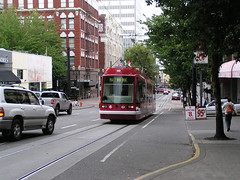 Portland Streetcar downtown.
Portland Streetcar downtown.The Portland transit line that is more comparable to some of the areas in the Washington region that are looking in part for neighborhood stabilization and improvement through the provision of increased transit, is the MAX Interstate-Yellow Line, which travels through Northeast Portland.
The Portland neighborhoods around the Interstate MAX Line are more comparable to some of the neighborhoods in NE and SE DC, as well as Columbia Pike, that are looking at streetcars. Places like the Pearl District and River Place in Portland are definitely "upscale" areas, although the downtown area between them varies and does have some vacant space (but also new construction of condominiums).
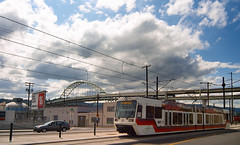 Interstate Max heads north under Fremont Bridge. Photo by Miles Hochsein, Portland Ground.
Interstate Max heads north under Fremont Bridge. Photo by Miles Hochsein, Portland Ground.Because of difficulties in getting funding through ballot initiatives, the Portland Development Commission, equivalent to DC's NCRC, but with a much longer track record and a real record as an operating concern--plus I don't think that Portland has a bunch of separate CDCs like DC--took the somewhat controversial step of creating the Interstate Urban Renewal District and floated bonds against the planned increase in property tax revenues associated with expected development benefits that would result from the creation of a new MAX light rail line. The bond monies paid for the creation of the Light Rail line.
This line provides service to an area of Portland that is considered less well off financially, with its only real African-American neighborhoods, etc. I think that's a better example for some of the things we are trying to do with streetcars here.
I don't really have great photos of the Interstate line, although I did get a specially escorted tour as part of the National Trust conference last October. I think that any DC-regional trips to Portland to view transit need to tour the MAX Interstate line as well, and talk with some of the same residents that I talked with, who might have been opponents originally, but have come to appreciate the benefits that being better connected brings to them.
I think the example of the Interstate Urban Renewal District in Portland is worth considering for Arlington and Fairfax Counties as they search for funding strategies for the Columbia Pike Streetcar.
Finally, the arguments that people raise about bus versus rail gloss over some real differences between bus and rail usage in the DC region. Last week, I saw a great presentation about Arlington County transit (by Dennis Leach, as part of a presentation sponsored by the Washington Regional Network). While bus usage has gone up in Arlington by a percentage point or two, I think the number for increase in rail transit usage is between 10-20% (I don't have my notes in front of me).
There is no denying that it is cheaper to "improve bus service," rather than to install and maintain streetcars, but that is an answer to a different question. The question isn't how to improve current service on the margins, but how to improve, enhance, and extend transit service more generally.
1. Rail accommodates more passengers for fewer personnel. *
2. People will ride rail who won't ride the bus.
3. This means that with streetcars you can serve current bus riders as well as new riders, benefiting both.
4. Real estate improvements-benefits are much greater in association with rail transit rather than bus-only transit. The return on investment from rail investments is far far far greater than when compared to bus service. That is reality. The best example is the creation of the infill New York Avenue station on the red line, which is accelerating development of previously disinvested areas, although at the same time it is pushing the transformation of some areas of the city in ways that can be construed as "gentrification." (This consequence was not planned for in a substantive way, although it was identified as an issue by me and others. I wrote about this on 10/22/2001...)
5. Finally, there is no way that even an improved bus can compare to the stability of the ride on fixed rail.
(* A major criticism of bus rapid transit is that the average 6 car light or heavy rail train has one operator, and moves 800 or more passengers. You need 8-12 buses, each with an operator, to do the same with BRT. Plus rail moves as much as 60% more people per hour per one lane of road-one line compared to BRT. )
I think the point about streetcar vs. bus is similar to the Post editorial about subway service to the Dulles Corridor, "Tunnel or Bust," which says "if the new rail line is to be built, which seems all but inevitable, it should be done right. And that means an underground tunnel through Tysons."
The point is if you're going to make large, frankly gargantuan public investments in transit infrastructure, do it so that it has value. Improved bus service will make service better for current patrons. I am all for that.
Or, improved transit service can make service better for current riders and attract significant numbers of new riders. This will contribute to more livable and walkable communities less dependent on cars (and gasoline or diesel oil, but still on coal for electricity), and will generate new investment, presumably of a compact pro-urban footprint. And it should reduce road congestion and the demand for more road lanes.
In short, if you are going to invest in transit, do it right. "Go by streetcar!"
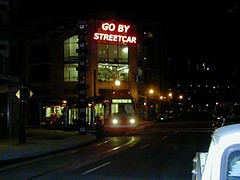 Photo by the Streetcar Lofts in the Pearl District from NW Virtual Transit.
Photo by the Streetcar Lofts in the Pearl District from NW Virtual Transit.Index Keywords: transit



0 Comments:
Post a Comment
<< Home